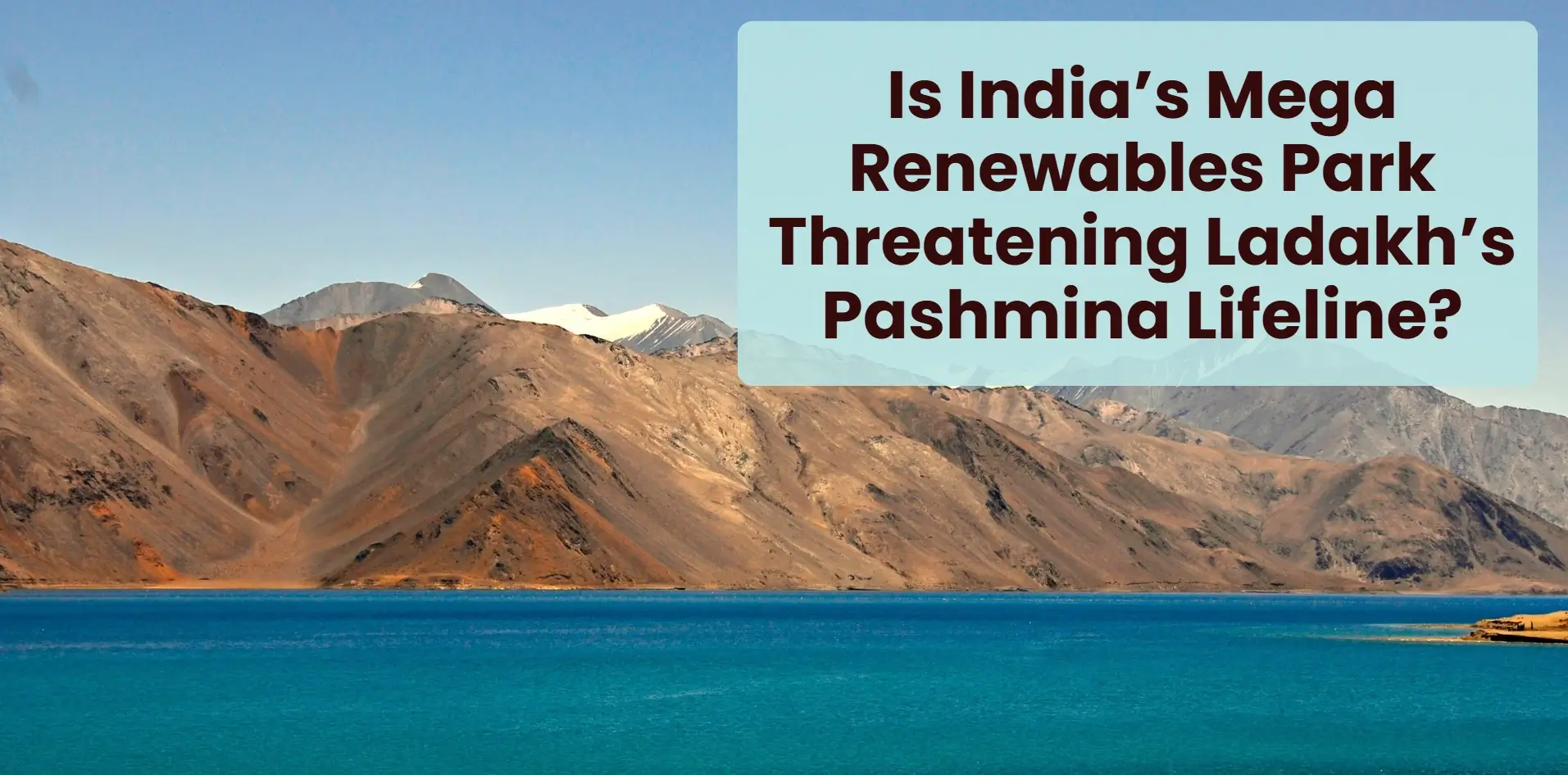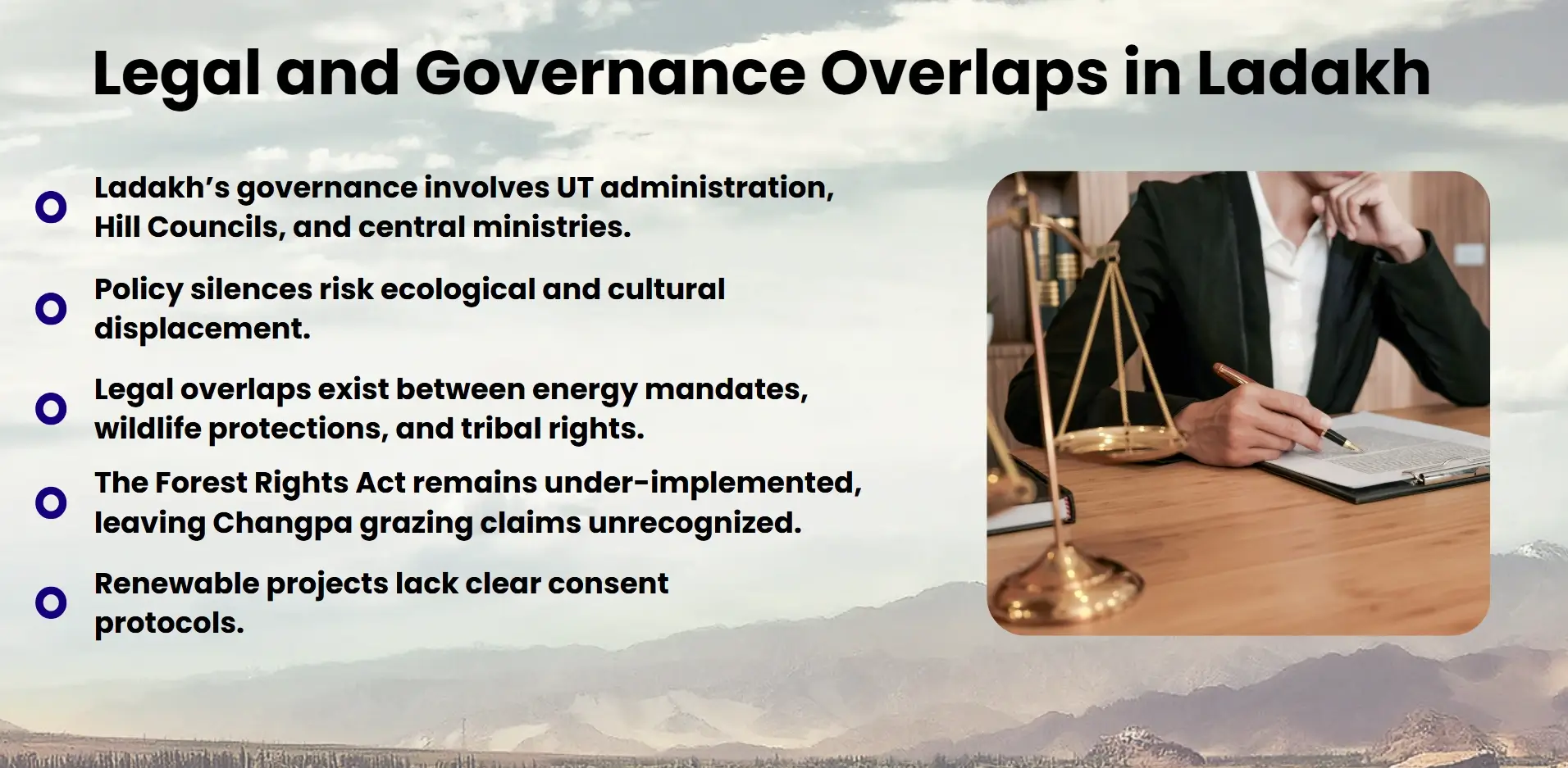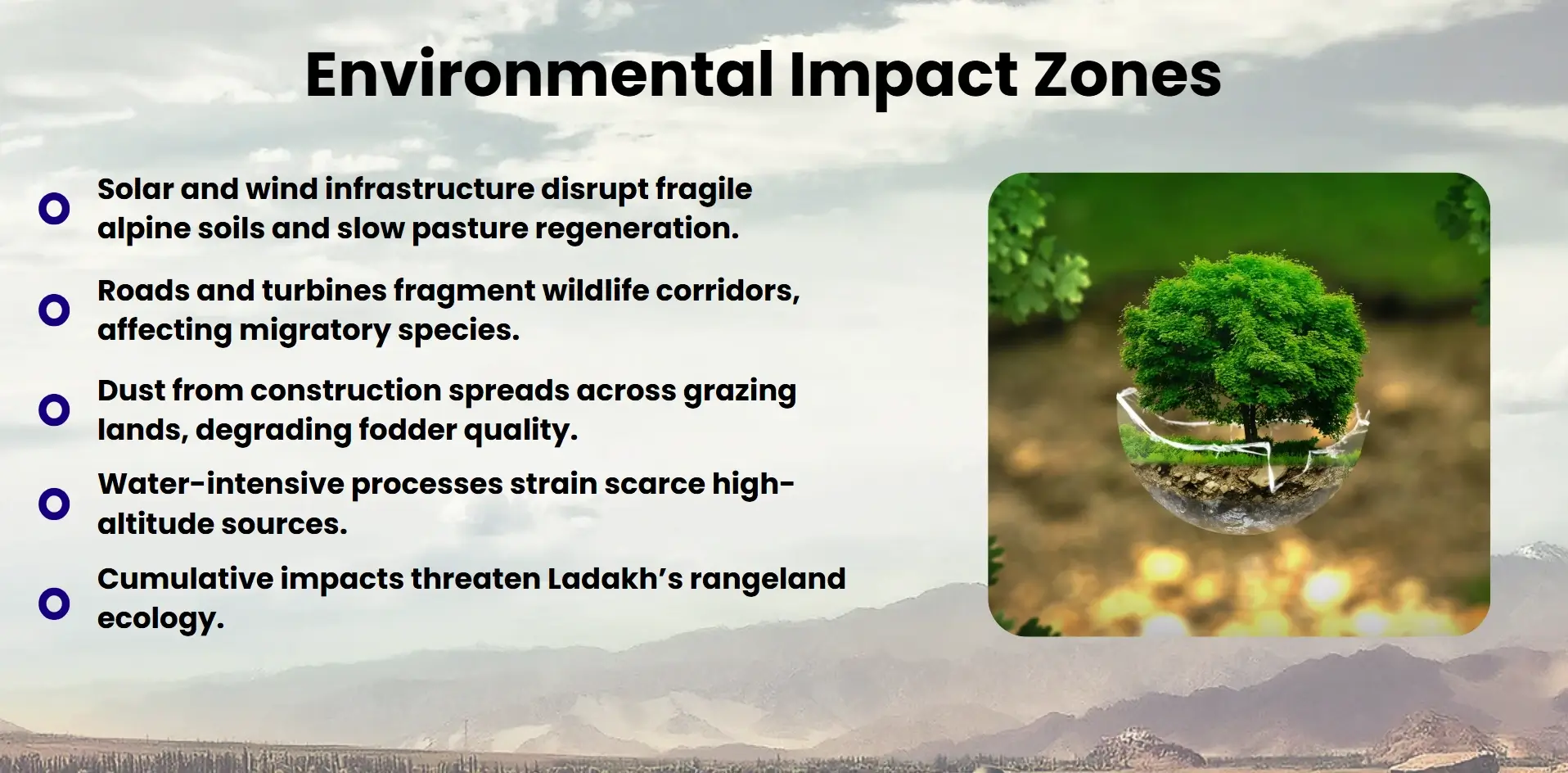India's mega renewables park project in Ladakh is facing criticism for potentially threatening the livelihoods of Changpa nomads, who depend on pashmina goat herding for their survival.The Ladakh renewables mega‑project in India promises to offer clean energy, but Changpanomads fear that it poses a threat to grazing lands, pashmina wool economy, delicate ecosystems, and centuries old culture.

One of India's largest renewable energy projects is a 60,000-crore solar-and-wind park that will supply millions of households in the cold desert of Ladakh, where blue skies clash with jagged mountain ranges. To the policymakers, the project represents a daring step towards achieving the climate targets of the country, and it will leverage the outstanding potential of the solar irradiance and wind in Ladakh. However, to the Changpa nomads, who rear sheep with the best quality pashmina in the world, the massive site have become more than a landscape transformation; it is now a threat to their grazing lands, nomadic migrations and their livelihood. These herders who live in high altitude have found over the centuries a precarious balance between the demands of people, precarious high alpine ecology and whatever routine their valuable pashmina goats are in. As government blueprints and visions herald a prospect of green growth, the Changpa are worried that this green growth should be and will be paid for with lives, work, abused ecology and loss of culture. This conflict i.e. “global environmental desire versus the existence of indigenous heritage,” is at the centre of a debate on just what sustainability really is within one of the most extreme, yet sensitive environments on the planet.
The Renewable Energy Park
A proposed hybrid renewable energy park is billed as a beacon of India'sshift to clean energy in Ladakh. Its size, pattern and grid connections will configure advantages and trade-offs through the coming decades.
Capacity and configuration
The park is projected to be a hybrid complex of 13 GW of utility‑scale solar, wind, and battery energy storage that is conceived as being located across Pang, Debring, and Kharnak. The first anchor will be the grid‑connected 25 MWac/50 MWdcSECIsolar plant at Taru, Leh, commissioned with 40 MWh storage, indicating the mix of technology and deployment experience that there will be in high altitude and dispatchable output outside the peak of sun availability.Indian forest cover in India Over the past 20 years, policy changes, land use dynamics, and conflicting conservation and development factors have caused minor variations in the nation's average forest cover.
Investment and Grid connectivity
The Inter‑State Transmission System under Green Energy Corridor (GEC‑II) will evacuate 13 GW to transport electricity to demand centres form this high plateau. Executed by the Power Grid Corporation of India Ltd., the scheme has an outlay of 20,773.70 crore and connections are to be established via Himachal Pradesh and Punjab into the national grid making the isolated resource in Ladakh into a nationally accessible capacity.
Why Ladakh
Site location is based on a record amount of solar and developing hybrid energy. Ladakh has more than 300 days of sunshine every year and possesses superior atmosphere clarity of the high altitude; winter winds supplement solar capacities. Decades of diesel dependence and off-grid pilot projects, most notably led by the Ladakh Renewable Energy Development Agency, have developed local expertise in solar, micro-hydro, and storage those are now growing at a village level to a gigawatt-sized potential.
Strategic significance
The park nationally supports clean-power acceleration. In combination with storage and an evacuation corridor, it will produce firm, exportable clean energy that should leverage a crowding-in of ancillary investment in logistics, services and maintenance. Choices of the major park developers are yet to be undertaken, which highlights the fact that ground alignments and implementation will be the deciding factors on whether the gains out-pictured can come through.
The Pashmina Ecosystem and the Changpa Nomads
The Changpa have a long history of survival under wind, grass, and goatsfolds in Ladakh, the high Changthang and have built pashmina economies on top of this rangeland goat-herding culture over generations.
Identity and landmass
These are an aboriginalsemi‑nomadic pastoral people of Ladakh. They navigate deadly cold and low oxygen, and scarce plants as they change their grazing route on a seasonal basis, high‑altitude grasslands in Rupshu and on lakes such as Tso Moriri and Pangong.Their way of life is influenced by the Buddhism and in some parts byTibetan nomadic practice. Their ease of movement, herding and camping (rebo tents, yak support) is an adaptation to this cold‑desert ecology and has resulted in a unique cultural identity after a millennium or more.
Fibre, markets and value
Changpa livelihoods revolve in the core of Changthangi (pashmina) goat whose undercoat contains the much-desired cashmere. A tiny proportion of this world cashmere is sold as the coveted “Ladakh Pashmina” due to its traceability and fineness of around 12-14 microns, and more often being marketed by the cooperatives of herders to achieve better prices, transparency of procurement and production that is not harmful to wildlife. It is a model that connects herders, artisans and conservation organizations, and is indicative of an emerging direction in which quality, provenance, and ecosystem management complement one another.

Change, mobility and stewardship
The socio-ecological compact is based on traditional rotational grazing, pasture set-asides, and co-existence with snow leopards and other wild fauna and has resulted in making it resilient to climatic stresses across the rangelands. But historic border closures shortened older trans-Himalayan routes; now modernization, younger migrant people, and declining or disputed grazing lands place new demands on a framework already adjusted to motion and interchange. Changthang first‐hand reports also record life change and environmental unpredictability due to climate change, which increases the importance of protection of migratory routes, water sources, and community management of the pastures.
Tensions Over Land, Livelihoods and the Law
This fusion of land, livelihood and law at Pang in the Ladakhi Changthang is about a renewables park along with the promise of clean energy, and about pastoral commons, the right to transit and the chance to thrive culturally, which confront an unknown future and an uncertain legal status.
Grazing rights and Tenure
A large part of the Changthang pasture cannot be claimed individually; the dry pasture is a customary common where the mobile herders pass through. Where projects are overlaying land classified as vacant, such use-rights are effaced on paper even though the property may be key to the economic base. Seasonal routes, salt-licks and water stations face the risk to be fenced, diverted, or bisected by distribution roads, towers and substations. In a movement and reciprocity-calibrated pastoral system continuity of rangeland is synonymous with continuity of the herd base, and the household economy based thereon.
Consent and Procedural Opacity
Pastoralists document that the consultations, which they say are few and sporadic, are more in the nature of an information session than an actual decision-makingprocess. Communities may not be able to evaluate the cost of concealment or bargain protection against the visibility of maps at parcel-level, timescales, and mitigation strategies. Big hybrid projects tend to balkanize approvals (generation, transmission, storage), blur responsibility, and make cumulative-impact assessment more difficult. Free, prior, and Informed Consent, which is a core competence of ethical development when working with the indigenous peoples, is more principle than practice and more so under time-constrained projects in the border districts.
Livelihood risk and under-compensation
Regimes of compensation normally depend on formal lands or crop documentation, which excludes mobile livelihoods, common pastures, and non-market aspects of livelihoods such as breed quality and fiber fineness. Temporary wage labor in the construction industry is not really a replacement formultigenerational herding experiences, herd ownership, and artisanal bonds in the pashmina supply chain.

Weak safeguards and overlapping laws
The mosaic of governance in Ladakh of Union Territory administration, Hill Councils, protected-area regulations, and national energy mandates leaves flaws and overlaps. Irregularities in the high-altitude pastoralist recognition have been reflected in the spirit behind the Forest Rights Act, a spirit of community right to tenure and habitat protection within which high-altitude pastoralists also locate; increased restrictions are due to federal regulation of wildlife and borders. It is in this uncertainty that public purpose could trump local demands unless a government codifies grazing privileges, establishes no-go habitats, mandates cumulativeEIAs and builds enforceable sharing of the benefits relative to rangeland condition.
Environmental and cultural Impact
At the wind-scoured high plateau of Ladakh, large turbines and panels confront crumbly soils and ways of herding that date back centuries, posing tough questions about what Green India Mission can be amid precariously balanced ecosystems and cultures in this day and age.
Environmental fragility
Cold deserts on high altitudes have slow recovery times. Grading of the arrays and roads loosens thin soils, increases in dust, and distorts the snowmelt-driven hydrology that supports meadows and wetlands. Habitat fragmentation may also cut offthe movement of wildlife-including and disrupt breeding grounds. Any small changes in water sources or salt licks reverberate through pastoral and wild herbivore behaviors, and creating localized construction onthe landscape scale.
Infrastructure footprint
Utility-scale build-outs introduce access roads, route corridors, substations, and lay-down yards. Essentially, each of these parts bites on adjacent pasture, establishing lines of encroachment fence, both real and environmental. The need to have water to clean the panels and construct the buildings is rare in Ladakh, and this will pose a problem as it will run out of community sources unless clean and closed restorative practices are made standards. Turbulence on wind farms, glare and traffic at maintenance facilities create chronic irritations, end‑of‑life waste (modules, blades, batteries) needs a plan that does not bottleneck remote communities.
Continuity and identity in culture
Changpa nomadism is a culture on the move: compartmentalised camps, habitual routes, and mutual control of pasture. Such arteries can be pinched by fixed infrastructure and made to make detours, straining herds and destroying time‑tested schedules. Displacement erodes the intergenerational knowledge of herd breeding, weather reading, fibre care, and breaks bonds to sacred places and communal practices that underpin the social safetynet as much as identity.

Mitigation design and climate justice
Fair transition needs more than compensation. It implies writing grazing entitlements; assigning no‑go core pasture and wildlife corridors; micro‑setting around watering sites; dry-cleaning requirements; construction holiday seasons; and rangeland health benefit-sharing as an enforceable obligation. Free, Prior and Informed Consent must be substantive, map-based, time-bound and re-negotiable such that clean power expansion does not become green dispossession.
Policy Dilemmas and the Moral Issues
Clean ambitions of energy in Ladakh against pastoral livelihoods and delicate ecologies that compel some tough decisions on who makes development, to whom and what is a just transition in border lands.
Competing Vision and Autonomy
A place-based, indigenous-led impact energy route and a technocratic, export-led drive towards mega-solar, wind, and related extraction are the two extremes that Ladakh is caught between during this transition. This conflict has also strengthened calls to constitutional protections, such as Sixth Schedule-style autonomous status and even statehood, by coalition groups like the Leh Apex Body and Kargil Democratic Alliance, andhas been fuelled by demonstrations into 2023-2024. Democratic control over land, livelihoods and energy destinies is at stake.
Rule and tacit agreement
Practice is ahead of policy design. Generations, transmission, storage, and land approvals generally have gone through silo approvals, which hide cumulative effects on rangeland and wildlife. Free, prior, and informed consent also becomes performative when parcel-level maps, seasonal movement data, and legally binding mitigation are not available. To these shortcomings, centralized decision-making in Ladakh as a Union Territory adds a centripetal pull that undermines deliberations in contexts with low reversibility and where the costs of error do not rise to the state budget paid by many generations.
Distributional Equity andPublic Purpose
The imposition of energy evacuated hundreds of kilometres to consumption centres may turn the elastic definition of the word public purpose into peripheral sacrifice, particularly when the compensation process pays little regard to mobile tenure, herd equity, and cultural significance. Via high-voltage corridors, massive central grants, and reliance on large-scale storage, the evacuation of the 13 GW Park adds edge viability and equity controversies: who takes losses on delays and overruns or grabs tidy revenues against sporadic wages and livelihoods disruption.
Design alternatives and responsibility
Ethical policy would overcome this by hard-wiring protection: no-go core pastures and wildlife corridors, micro-siting around water points, seasonal construction blackouts, dry-cleaning requirements, recycling, and benefit-sharing linked to the state of the rangeland. Agri-pastoral co-use, including agri-tethering and grazing under raised arrays, is demonstrated and needs careful, co-developed pilotsto Changpa and follow-through monitoring prior to scale-up rather than after. Unless these are the case, green growth may be transformed into green dispossession.
Conclusion
Ladakh Green Park is another example of what the promise and dangers of a green transition entail regarding India. As electricity that would power millions and help the country achieve climate targets, it may further displace the Changpa nomads from their traditional grazing grounds, cripple the pashmina economy, and change the tenuous high‑altitude ecology. The conflict is not merely one over the use of land, but one over the nature of sustainability, whether it can be reached without destroying societies and ways of life that have existed side by side with a hostile environment in symbiosis for a millennium or more. The real just energy future requires co-created solutions: protecting indigenous rights, preserving biodiversity and having the benefits of development flow fairly and equitably down to what is most impacted. The Ladakh case poses an essential question to the Indian climate future, i.e.,can progress be measured not only in megawatts, but in the resilience of peopleand places that power them?